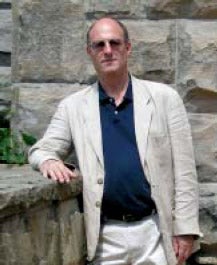Three new faculty members in Arts and Sciences have been
appointed as department chairs: Merlin Donald in cognitive
science, Charles Burroughs in art history and art, and Per Aage
Brandt in modern languages and literatures. The previous issue
of art/sci led off with the news of Professor Donald’s
appointment. For this issue, Charles Burroughs, the Elsie B.
Smith Professor of Liberal Arts, has written about his career,
his research interests, and his hopes for his department. A
story on Professor Brandt will appear in the next issue of
art/sci.
 |
| Charles Burroughs |
I am an art and architectural historian with broad scholarly
interests, though my major area of specialization has been Italy
between the thirteenth and seventeenth centuries. I have
published a range of studies on well-known protagonists of
cultural transformation, including Michelangelo, Brunelleschi,
Alberti, Palladio, Botticelli, and some of the most important
papal patrons of the period. But I have a particular interest in
the anonymous or vernacular practices that shape both urban and
rural environments. My first book, From Signs to Design:
Environmental Process and Reform in Early Renaissance Rome
(MIT Press, 1990), explored the emergence of new forms of urban
living and models of urban space—forms that inspired, but did
not depend on, conscious planning.
In some studies, I have concentrated on architecture; in
others, on the production of images. I sought to integrate these
interests, as well as my reading of late-medieval Florentine
literature, in a recent book, The Italian Renaissance Palace
Fašade: Structures of Authority, Surfaces of Sense
(Cambridge University Press, 2002). In this project I explore
the “fašade” as a central notion in understanding the cultural
world as well as the key architectural conceptions of late
medieval and early modern Italy (and by extension Europe). For
example, I explore the relationship between fašade design and
the well-known contemporary interest in reading a person’s
character from the exterior, e.g., through physiognomy, and
conversely in resisting such legibility, through dissimulation.
My current projects include a study of the idea of origin
(i.e., of architecture, society, the city, etc.) in early
Renaissance Florence, and a related exploration of neglected
dimensions of Botticelli’s famous mythological painting the
Primavera. In addition, I am part of an international team
of scholars, including experts in labor and environmental
history, that recently won a Getty Foundation Collaborative
Award for a study of plantation landscapes and architecture, and
the representation of these in a range of media and contexts, in
the Atlantic world in the eighteenth and nineteenth centuries.
My interest in and experience of cross-disciplinary research
and pedagogy, not least across the traditional boundary between
the humanities and sciences, resonate with current concerns
here. I am excited to work in an institutional milieu in which
the questioning of existing pedagogical patterns and practices
is the order of the day. And it is invigorating for me to be
back, once again, in a major city, one engaged, with whatever
prospects of success, in an ambitious program of redefinition in
which cultural institutions and the visual and other arts
already play a crucial role.
Many people I have met clearly wonder why anyone would accept
a position in this department just as the Cleveland Museum of
Art is about to close for several years. This is undoubtedly a
major blow to the department, but it also creates an opportunity
for us to consider the nature of our links with the Museum, and
indeed to think about the actual and potential place in
contemporary society of museums and the artworks they harbor.
The department also includes a lively studio program with a
particular commitment to multicultural art and design teaching
and a close relationship with the Cleveland Institute of Art. It
is therefore an excellent platform from which to consider a wide
range of ways to make art and to study artistic making as well
as ways of writing about and responding to the visual arts.
I am honored to find myself a member of, and to have the
opportunity to lead, an extremely distinguished and highly
visible group of art historians, and to do so within the larger,
ambitiously conceived interdisciplinary environment of the
College of Arts and Sciences, indeed of the University as a
whole. |